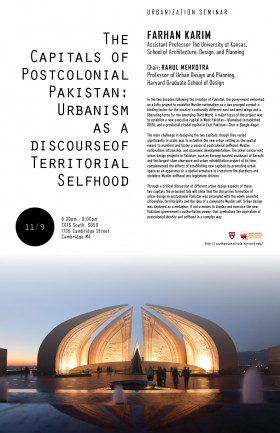Urbanization Seminar
Farhan Karim, Assistant Professor The University of Kansas, School of Architecture, Design, and Planning
Chair: Rahul Mehrotra, Professor of Urban Design and Planning, Harvard Graduate School of Design
In the two decades following the creation of Pakistan, the government embarked on a lofty project to establish Muslim nationalism as a two pronged symbol: a binding factor for the country’s culturally different east and west wings and a liberating force for the emerging Third World. A major focus of the project was to establish a new executive capital in West Pakistan—Islamabad (established 1959), and a provincial citadel capital in East Pakistan—Sher-e-Bangla Nagar. These two new capitals were conceived as the backdrop to accommodate the new quintessential democratic institutions: parliament buildings, universities, education training centers and polytechnic institutes. However, Pakistan’s shortage of architects and urban planners, in tandem with the country’s martial government’s Cold War leaning towards the Unite States, eventually compelled the government to seek technical assistance from USAID and the Ford Foundation, and commissioned Constantine Doxiadis and Louis Kahn to design Islamabad and Sher-e-Bangla Nagar respectively. The main challenge in designing the two capitals, though they varied significantly in scale, was to establish the new urban setting as the spatial means to manifest and foster a sense of postcolonial selfhood, Muslim nationalism, citizenship, and economic developmentalism. The other concurrent urban design projects in Pakistan, such as Korangi located southeast of Karachi and the largest slum clearance and urban rehabilitation project of its time, complemented the efforts of establishing new capitals by promoting urban space as an apparatus or a spatial armature to transform the placeless and stateless Muslim selfhood into legitimate citizens. Through a critical discussion of different urban design aspects of these two capitals the proposed talk will show that the discursive formation of urban design in postcolonial Pakistan was entangled with the newly anointed citizenship, territoriality and the idea of a composite Muslim self. Urban design was deployed as a metaphor, if not a means to display and exercise the new Pakistani government’s authoritative power, that symbolizes the aspiration of postcolonial identity and selfhood in a complex way.

